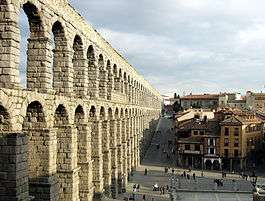Aqua Marcia
The Aqua Marcia (Italian: Acqua Marcia) was one of the longest of the 11 aqueducts that supplied the city of ancient Rome. The aqueduct was built between 144–140 BC, during the Roman Republic. The still-functioning Acqua Felice from 1586 runs on long stretches along the route of the Aqua Marcia.
Together with the Aqua Anio Vetus, Aqua Anio Novus and Aqua Claudia, it is regarded as one of the "four great aqueducts of Rome."[1]
Route
The ancient source for the aqueduct was near the modern towns of Arsoli and Agosta, over 91 km (57 mi) away in the Anio valley. This general locale, in hills to the east of the city, was also used for other aqueducts including the Anio Vetus, Anio Novus, and Aqua Claudia. The same source is used today to supply the modern aqueduct.
The Aqua Marcia supplied water to the Viminal Hill in the north of Rome, and from there to the Caelian, Aventine, Palatine, and Capitoline regions of the city. Its extension to the Capitoline Hill caused a controversy at the time, because traditionalists were concerned about a passage in the Sibylline Books warning against bringing water there.[2]
History
The Aqua Marcia was constructed from 144 to 140 BC by the praetor Quintus Marcius Rex (an ancestor of Julius Caesar), for whom it is named.
The aqueduct was largely paid for by spoils from the recent Roman conquests of Corinth in 146 BC and the destruction of Carthage at the end of the Third Punic War, in the same year.[3]
The aqueduct followed the via Tiburtina into Rome, and entered the city in its eastern boundary at the Porta Tiburtina of the Aurelian Wall. It was well known for its cold and pure waters.
The aqueduct was repaired by Marcus Agrippa in 33 BC, and then later again by Augustus, according to the inscription in the arch that was later made into the Porta Tiburtina. Augustus also augmented the supply by linking it to an additional source, the Aqua Augusta, doubling the throughput. Much of its supply was siphoned off by private citizens for their own use, making it effectively only a trickle in the city by the time of Nero. The supply was increased again by later emperors. By the time Frontinus measured the city's aqueducts around 97 AD, the Aqua Marcia was capable of supplying 187,600,000 l (49,600,000 US gal; 41,300,000 imp gal) of water a day, the second-greatest source of the city's water.
Gallery
 Aqua Marcia near Romavecchia, Rome
Aqua Marcia near Romavecchia, Rome Route of the Aqua Marcia outside of Rome
Route of the Aqua Marcia outside of Rome- Route of the Aqua Marcia within Rome
 Closeup on the Roman waterproof mortar inside of the channel
Closeup on the Roman waterproof mortar inside of the channel
References
- Coarelli, Filippo, Guida Archeologica di Roma, Arnoldo Mondadori Editore, Milano, 1989.
- Claridge, Amanda, Rome: An Oxford Archaeological Guide, Oxford University Press, New York, 1998
Notes
- ↑ Blackman, Deane R. "The Volume of Water Delivered by the Four Great Aqueducts of Rome." Papers of the British School at Rome 46 (1978): 52-72. https://www.jstor.org/stable/40310747.
- ↑ Stambaugh, p. 37.
- ↑ Stambaugh, John E (1988), The Ancient Roman City, Johns Hopkins University Press, p. 36 .
External links
See also
| Wikimedia Commons has media related to Aqua Marcia (Rome). |
